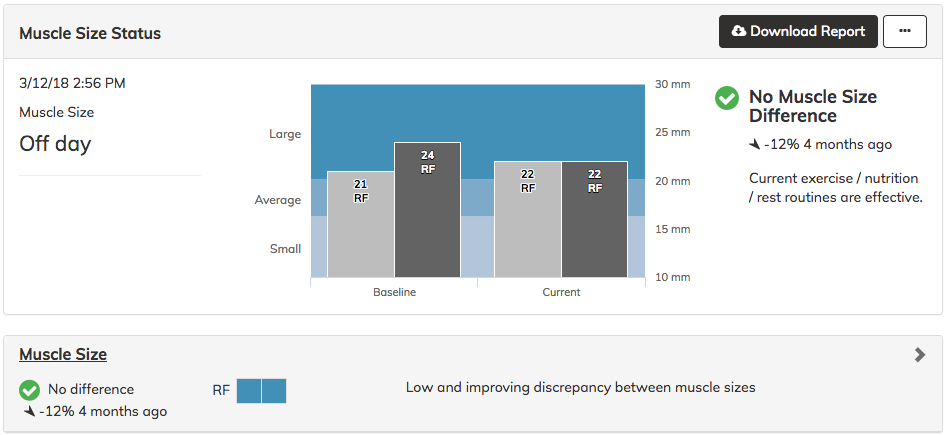MuscleHealth is defined as “The capacity of a muscle to store, generate and replenish energy” and is made up of several key factors: Muscle Size, Muscle Quality, Muscle Fuel and Body Composition.
The current NBA schedule is one of the most demanding in all of professional athletics. With an average of only approximately 1.5 days between games, and 41 games played on the road, MuscleHealth recovery from the previous game’s load combined with the stresses of frequent travel presents a considerable challenge. In fact, it is likely that NBA players never fully reach their optimum MuscleHealth during the season without the more extended rest available only at the All Star break, or the occasions when they are able to take consecutive nights off. In light of this, it is essential for NBA teams to consider the complex processes of rest and refueling as they relate to such short time constraints. With MuscleSound, optimizing MuscleHealth in elite athletes across the grind of the NBA season is now possible thanks to our patented ultrasound technology and system of assessments.

‘Muscle Size’ Assessment:
In addition to micro level game-to-game recovery, our assessments can also provide additional high level information on MuscleHealth as it relates to longer time periods. A new positive trend in the NBA is players “leaning down” to discard excess weight that can result in the added quickness and endurance necessary to excel in today’s stretched out, fast pace game. Additionally, some players and coaches – based on their own knowledge and experience – have suggested that it can also result in less long term wear and tear of the body’s structures, potentially leading to an extension of a player’s career. Within the context of this new weight loss trend, NBA players face the distinct challenge of maintaining consistent muscle mass throughout the season.
Studies have shown that when exercising with very low glycogen stores the body will go on to use fat and even muscle as its reserve energy source (San Millán I, 2103), and that when glycogen stores are diminished, a muscle’s ability to produce force contraction may be proportionally diminished as well (Ørtenblad, et al, 2011).
Considering the limited window for refueling muscles, athletes with already lower body fat stores are at risk for utilizing muscle mass as energy during intense exercise. Again, there may be a need to closely monitor pre-game, in-game, and post-game fuel intake to adequately replenish and rebuild the muscles in a short time period, thus ensuring this aspect of longer term MuscleHealth remains optimized. A team nutritionist should be consulted on this and individual fueling programs developed accordingly.
Another basketball specific challenge that can be monitored with our Muscle Size assessment are problems associated with muscle dominance. There are many movements during a basketball game in which one leg or arm is extensively used (jumping, shooting), and frequently those movements are dictated by an individual’s dominant side. As a result, it is very common for an imbalances to develop between alternate sides of the same muscle. These imbalances can have an effect on overall performance, and even lead to higher risk of injury if game flow requires immediate or prolonged use of the underdeveloped side. Any significant differences measured in Muscle Size will be alerted immediately to the user at the time of scanning, allowing training routines to be altered appropriately to mitigate any discrepancies.
We recommend utilizing our Muscle Size assessment every 3-4 weeks to accurately track any changes to an individual’s muscle mass throughout the season and provide further insurance that muscles remain as healthy as possible over extended periods of consistent stress. With these patented MuscleSound assessments, not only can you track game to game fuel level recovery and optimize short term refueling protocols, but you can also track your players from a longitudinal standpoint across the course of the grinding season, and ensure players overall Muscle Health is fully optimized from multiple standpoints.
MuscleSound Summary
The continued use and development of MuscleSound enables the appreciation and attainment of optimal game readiness for every athlete. This readiness is a continuous balancing act between the physical and psychological responses to workload (games/training), individualized nutrition, and regeneration/recovery from those efforts. MuscleSound, along with the compilation and analysis of objective data from both individual and team, enables informed assessments to be made of the game readiness and health status of each athlete. To achieve these goals, we recommend the following actions:
- Ensure consistent nutritional monitoring
- Monitor each athlete’s unique readiness & recovery capacities for game and/or training
- Assess muscle fuel levels to help adjust with physical workloads.
- Increase each athlete’s individual muscle database with more frequent scans for optimization of readiness and recovery
- Find muscles that may be more vulnerable to strains, and assess for muscle symmetry across limbs to help prevent biomechanical variability
References:
Ørtenblad N, Nielsen J, Saltin B, Holmberg HC. Role of glycogen availability in sarcoplasmic reticulum Ca2+ kinetics in human skeletal muscle. J Physiol 589.3 (2011) pp 711–725
San Millán, I. The Importance of Carbohydrates and Glycogen for Athletes. Training Peaks: http://bit.ly/1Myfmrc, 2013.
